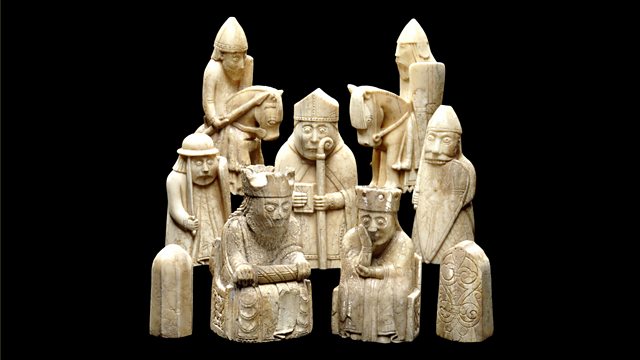Lewis Chessmen
The history of the world as told through objects. This week Neil MacGregor, the director of the British Museum, explores the story of the Lewis chessmen.
This week Neil MacGregor, the director of the British Museum, has chosen some of the great status symbols of the world around 700 years ago - objects with quite surprising links across the globe.
Today he is with one of the most familiar objects at the museum; a board game, found in the Outer Hebrides but probably made in Norway - the Lewis Chessmen. They are carved out of ivory and many of the figures are hugely detailed and wonderfully expressive. They take us to the world of Northern Europe at a time when Norway ruled parts of Scotland and Neil describes the medieval world of the chessmen and explains how the game evolved. The historian Miri Rubin considers the genesis of the pieces and the novelist Martin Amis celebrates the metaphorical power of the game of chess.
Producer: Anthony Denselow
Last on
More episodes
Previous
You are at the first episode
![]()
A History of the World in 100 Objects - objects related to money, trade and travel.
About this object
Location: Probably Norway
Culture: Middle Ages
Period: 1150-1200
Material: Animal Material
听
These chess pieces were found unexpectedly on a beach on the Isle of Lewis in Scotland in 1831. They were carved from walrus ivory and whale tooth between around 1150 and 1200. When found some were stained red, suggesting that the original colour combination of the pieces was red and white. The chess pieces were probably made in Norway. At this time the Isle of Lewis was part of the kingdom of Norway. The chess pieces may have been buried by a merchant travelling along the trade route from Scandinavia to Ireland.
Where did chess originate?
Chess originated in India after 500 BC and had arrived in Christian Europe via the Islamic world by at least the AD 990s. The original Indian and Islamic game was adapted to reflect medieval European society, so that the Indian war elephant was replaced with the figure of the bishop. The rooks biting their shields resemble the Viking berserkers of Norse myth, while the pose of the queens is derived from depictions of the grieving Virgin Mary. The pawns, lacking any human features, reflect the abstract pieces used in the Islamic version of the game.
Did you know?
- The name rook comes from Persian word rukh, which means chariot, and was the original Indian form of the modern castle.
Playing it for laughs
By James Robinson, curator, British Museum
听
Few objects compete with the Lewis chessmen in terms of their popular appeal. These endearing little figures have attracted audiences to the British Museum since the moment of their acquisition in 1831.
In recent years, they have found new fame from their inclusion in the 2001 film adaptation of Harry Potter and the Philosopher鈥檚 Stone. In the film, Harry and Ron compete at wizard鈥檚 chess using replicas of the Lewis chessmen. At the critical moment of victory, an enraged queen stands from her throne which she picks up to smash across her opponent.
This animated sequence taps into a longstanding appreciation of the Lewis chessmen鈥檚 comic qualities. But were they made for laughs?
The pieces that probably raise the biggest smiles are the famously grumpy queens who rest their chins in their hands, nursing a toothache or fretting about the weather. The bulging eyed foot soldiers that bite their shields with enlarged teeth come a close second. But, although we can never be certain what the carver originally intended, it is worth looking at the wider context to try to understand the significance of these figures for a twelfth century audience.
Chess was conceived and developed as a game of intellect and skill. Though increasingly played by mixed sex opponents where it acted as a forum for flirtation, it was initially cultivated in knightly circles as a game that sharpened strategic thinking.
Chess, indeed, is generally played in earnest and rarely provokes a laugh. It is essentially a war game and it is the horror of the battlefield that is probably reflected in the poses of these two very distinctive pieces.
The queen鈥檚 attitude is derived from contemporary depictions of the Virgin Mary in contemplation of the crucified Christ. On the chessboard she undoubtedly surveys the carnage and considers what solace she can offer. The foot soldier, conversely, is a figure of great heroic ferocity drawn from Norse legend.
Known as berserkers, these fictional warriors are described in the sagas as biting their shields in a state of self-induced frenzy.
Rather than figures of fun, the chessmen represent the feudal order of society and convey the qualities of king, bishop, knight and soldier through the language of gesture. Despite their miniature size, they might be seen to embody truly monumental values of the human condition.
Transcript
Broadcasts
- Mon 28 Jun 2010 09:4591热爆 Radio 4 FM
- Mon 28 Jun 2010 19:4591热爆 Radio 4
- Tue 29 Jun 2010 00:3091热爆 Radio 4
- Mon 5 Jul 2021 13:4591热爆 Radio 4
Featured in...
![]()
Money, Trade and Travel—A History of the World in 100 Objects
A History of the World in 100 Objects - objects related to money, trade and travel.
Podcast
-
![]()
A History of the World in 100 Objects
Director of the British Museum, Neil MacGregor, retells humanity's history through objects





